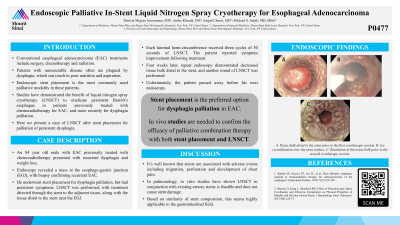Sunday Poster Session
Category: Esophagus
P0477 - Endoscopic Palliative In-Stent Liquid Nitrogen Spray Cryotherapy for Esophageal Adenocarcinoma
Sunday, October 22, 2023
3:30 PM - 7:00 PM PT
Location: Exhibit Hall

Has Audio

Patricia Miguez Arosemena, MD
Mount Sinai West and Morningside
New York, NY
Presenting Author(s)
Award: Presidential Poster Award
Patricia Miguez Arosemena, MD1, Andre Khazak, DO2, Angad Uberoi, MD1, Michael S.. Smith, MD, MBA3
1Mount Sinai West and Morningside, New York, NY; 2Mount Sinai Beth Israel, New York, NY; 3Icahn School of Medicine at Mount Sinai, New York, NY
Introduction: Conventional esophageal adenocarcinoma (EAC) treatments include surgery, chemotherapy and radiation. Patients with unresectable disease often are plagued by dysphagia, which can result in poor nutrition and aspiration. Endoscopic stent placement is the most commonly used palliative modality in these patients. Studies have demonstrated the benefit of liquid nitrogen spray cryotherapy (LNSCT) to eradicate persistent Barrett’s esophagus in patients previously treated with chemoradiotherapy for EAC, and more recently for dysphagia palliation. Here we present a case of LNSCT after stent placement for palliation of persistent dysphagia.
Case Description/Methods: An 84 year old male with EAC previously treated with chemoradiotherapy presented with recurrent dysphagia and weight loss. Endoscopy revealed a mass at the esophago-gastric junction (EGJ), with biopsy confirming recurrent EAC. He underwent stent placement for dysphagia palliation, but had persistent symptoms. LNSCT was performed, with treatment directed through the stent to the adjacent tissue, along with the tissue distal to the stent near the EGJ. Each luminal hemi-circumference received three cycles of 30 seconds of LNSCT. The patient reported symptom improvement following treatment. Four weeks later, repeat endoscopy demonstrated decreased tissue bulk distal to the stent, and another round of LNSCT was performed. Unfortunately, the patient passed away before further his next endoscopy.
Discussion: Stent placement is a preferred option for dysphagia palliation in EAC. However, stents are associated with adverse events including migration, perforation and development of chest pain. In pulmonology, in vitro studies have shown LNSCT in conjunction with existing airway stents is feasible and does not cause stent damage. Based on similarity of stent composition, this seems highly applicable to the gastrointestinal field. Further in vivo studies are needed to confirm the efficacy of palliative combination therapy with both stent placement and LNSCT.
1. Barthel JS, Kucera ST, Lin JL, et al. Does Barrett's esophagus respond to chemoradiation therapy for adenocarcinoma of the esophagus?. Gastrointest Endosc. 2010;71(2):235-240.
2. Sharma D, Kang L, Shepherd RW. Effect of Bronchoscopic Spray Cryotherapy and Ultra-low Temperature on Physical Properties of Metallic and Silicone Airway Stents. J Bronchology Interv Pulmonol. 2023;30(1):24-31.

Disclosures:
Patricia Miguez Arosemena, MD1, Andre Khazak, DO2, Angad Uberoi, MD1, Michael S.. Smith, MD, MBA3. P0477 - Endoscopic Palliative In-Stent Liquid Nitrogen Spray Cryotherapy for Esophageal Adenocarcinoma, ACG 2023 Annual Scientific Meeting Abstracts. Vancouver, BC, Canada: American College of Gastroenterology.
Patricia Miguez Arosemena, MD1, Andre Khazak, DO2, Angad Uberoi, MD1, Michael S.. Smith, MD, MBA3
1Mount Sinai West and Morningside, New York, NY; 2Mount Sinai Beth Israel, New York, NY; 3Icahn School of Medicine at Mount Sinai, New York, NY
Introduction: Conventional esophageal adenocarcinoma (EAC) treatments include surgery, chemotherapy and radiation. Patients with unresectable disease often are plagued by dysphagia, which can result in poor nutrition and aspiration. Endoscopic stent placement is the most commonly used palliative modality in these patients. Studies have demonstrated the benefit of liquid nitrogen spray cryotherapy (LNSCT) to eradicate persistent Barrett’s esophagus in patients previously treated with chemoradiotherapy for EAC, and more recently for dysphagia palliation. Here we present a case of LNSCT after stent placement for palliation of persistent dysphagia.
Case Description/Methods: An 84 year old male with EAC previously treated with chemoradiotherapy presented with recurrent dysphagia and weight loss. Endoscopy revealed a mass at the esophago-gastric junction (EGJ), with biopsy confirming recurrent EAC. He underwent stent placement for dysphagia palliation, but had persistent symptoms. LNSCT was performed, with treatment directed through the stent to the adjacent tissue, along with the tissue distal to the stent near the EGJ. Each luminal hemi-circumference received three cycles of 30 seconds of LNSCT. The patient reported symptom improvement following treatment. Four weeks later, repeat endoscopy demonstrated decreased tissue bulk distal to the stent, and another round of LNSCT was performed. Unfortunately, the patient passed away before further his next endoscopy.
Discussion: Stent placement is a preferred option for dysphagia palliation in EAC. However, stents are associated with adverse events including migration, perforation and development of chest pain. In pulmonology, in vitro studies have shown LNSCT in conjunction with existing airway stents is feasible and does not cause stent damage. Based on similarity of stent composition, this seems highly applicable to the gastrointestinal field. Further in vivo studies are needed to confirm the efficacy of palliative combination therapy with both stent placement and LNSCT.
1. Barthel JS, Kucera ST, Lin JL, et al. Does Barrett's esophagus respond to chemoradiation therapy for adenocarcinoma of the esophagus?. Gastrointest Endosc. 2010;71(2):235-240.
2. Sharma D, Kang L, Shepherd RW. Effect of Bronchoscopic Spray Cryotherapy and Ultra-low Temperature on Physical Properties of Metallic and Silicone Airway Stents. J Bronchology Interv Pulmonol. 2023;30(1):24-31.

Figure: A. Tissue bulk distal to the stent prior to the first cryotherapy session.
B. Ice crystallization over the stent surface.
C. Resolution of the tissue bulk prior to the second cryotherapy session.
B. Ice crystallization over the stent surface.
C. Resolution of the tissue bulk prior to the second cryotherapy session.
Disclosures:
Patricia Miguez Arosemena indicated no relevant financial relationships.
Andre Khazak indicated no relevant financial relationships.
Angad Uberoi indicated no relevant financial relationships.
Michael Smith: Castle Biosciences – Consultant. CDx Diagnostics – Consultant. Lucid Diagnostics – Consultant. Provation Medical – Consultant. Steris Endoscopy – Consultant.
Patricia Miguez Arosemena, MD1, Andre Khazak, DO2, Angad Uberoi, MD1, Michael S.. Smith, MD, MBA3. P0477 - Endoscopic Palliative In-Stent Liquid Nitrogen Spray Cryotherapy for Esophageal Adenocarcinoma, ACG 2023 Annual Scientific Meeting Abstracts. Vancouver, BC, Canada: American College of Gastroenterology.

